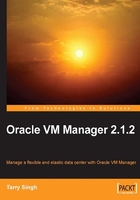
What this book covers
The book is designed so that you can dive into chapters on your own, as the chapters will be written independently of each other. You can use them both as reference as well as detailed guidance, purely based on you current focus. So for instance, you may want to do a quick installation of the Oracle VM Server, and then jump to Chapter 3 directly. My intention is to keep this book both conversational as well as provide screenshots to satisfy your needs.
I would recommend beginners to read the book chapter by chapter, increasing the pace as you move ahead with your installations. As the chapters progress, while not necessarily complex, they may require you to dig into some of skills in Linux, Virtualization, and so on. But like I said in the beginning, you need to have some sort of understanding on virtualization and a bit of experience as well. The latter part of the book concentrates on the VM management, a more fun part after you are done with installing and understanding the architecture of the Oracle VM platform.
I have divided the book into two parts, Getting Started and Looking into the Architecture and Management. In the first section, you will learn a little bit about the Oracle VM platform and the components of the Oracle VM platform. In the next part, you will get into the fun part of managing the VMs across a typical high-availability Oracle VM platform by using the Oracle VM Manager.
Part l: Getting Started
The first few chapters introduce the Oracle VM platform. Then we will go about installing Oracle VM manager and Oracle VM Server. You will carefully select the hardware and/or software platforms to carry out these installations.
I have typically chosen two environments and both happen to be hardware platforms. I will explain in detail the architecture that I have chosen for the purpose of writing this book, and also why.
In this section we provide general information about Oracle VM Manager, Oracle VM Server, and Oracle VM Agent. We will explain how Oracle's VM Manager, a typical ADF web application, can act as a frontend in a typical Cloud architecture, and why Oracle VM Server (which is derived from XEN Hypervisor, a rather popular Hypervisor used by Amazon EC2 type of installations) complements the Cloud services architecture in the backend of the Data Center.
We will go about explaining what Oracle VM Manager is, what is new in the Oracle VM platform 2.1.2, where you can find it, how to install it, and how to get started. And obviously we will end with the "why you should choose Oracle VM Server and Oracle VM Manager" above other virtualization solutions.
Here you go about configuring the Oracle VM Manager and go through the regular pre-installation checklists. What kind of hardware requirements you could best use, and which type of Operating Systems could be used to install the Oracle VM Manager upon.
We will get into details here and go ahead with successfully installing Oracle VM Server.
Part II: Looking into the Architecture and Management
These chapters are intended for all Data Center administrators, architects, and system builders, just about anyone who is interested in knowing and managing Virtual Machines on Oracle's VM platform.
There are no really advanced features such as testing Oracle RAC on a typical multiple-Oracle VM Server node, but it will have enough meat to not only do things through the feature rich VM Manager web application, but also to get your hands dirty with the console.
The main purpose of this section of the book is to see what really happens on the Oracle VM platform and how we can manage multiple Virtual Machines.
Here we will get into the management of the Oracle VM servers such as the addition of nodes, removing nodes, editing nodes, and starting and shutting down the nodes.
We will manage the Oracle VM server pool, explore the principles of designing the server pool, and creating and enabling the HA—all of the meaty stuff is explained here. This chapter will be interesting for anyone who wants to learn about managing the Oracle VM Manager.
In this part, we will go about explaining what VMs are, how we create them, how to startup-shutdown those VMs, typical console based actions required to manage the VMs, and basic configuration tasks around VM management.
We will discuss what Guest VMs are supported on Oracle VM Servers and do a quick install of one of them.
Continuing from the previous chapter we will go about managing the VMs and exploring the VMs through the Oracle VM Manager, such as viewing VM information or details, editing configurations, and other advanced functions such as Live VM Migration.
In the final part, we shall be performing some typical VM resource management tasks, such as importing VMs via several methods such as templates, VM Images, ISO files, and so on. We will also look briefly at creating shared storage.
Like any other tool, this platform will not be completely free from problems and here we will explain briefly about the problems you can run into, and what steps you must take to remediate them.